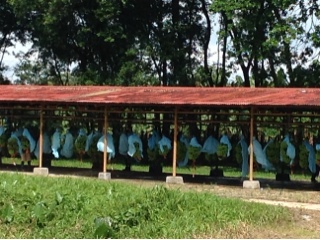Costa Rica receives over 214" of rain a year and for this reason, there are deep ditches along the rows of banana plants to drain excess water. The banana tree is 85% water, so too little water is never an issue. The first sight that greets us are the rows of blue bags on the trees.
Out in the field
Coming in from the field on conveyer belt.
The bags control the amount of ethylene which determines the ripening. There is no actual season for growing the bananas as they grow year round. At the bottom of each bag is a colored ribbon designating a time period when the bag was attached to the bunch of bananas. Bunches with the same color ribbon are processed together and go in the same container. Depending on how long it takes to ship-- 2 weeks to US and Canada and 4 weeks to European and Middle East, the ribbons tell them which bananas will ripen when, hence which bunch to ship where! I will never look at another banana the same way.The bananas are sorted, washed, packed in trays, labeled and placed in containers ready for shipment. Normally takes 8 hours work to fill a container. Seeing how many times they are handled, it is amazing that bananas ever sell for $.39/lb. That doesn't even count the actuall shipping, then stocking at the store.
Ready for processing.
The plantations are owned by the government and run by a cooperative. The big fruit companies buy from the cooperative. This is different than in Hawaii where the companies own the plantation as in a Dole Pineapple Plantation we visited.




No comments:
Post a Comment